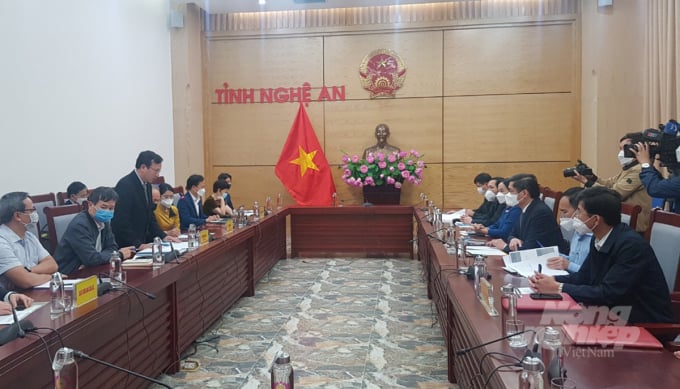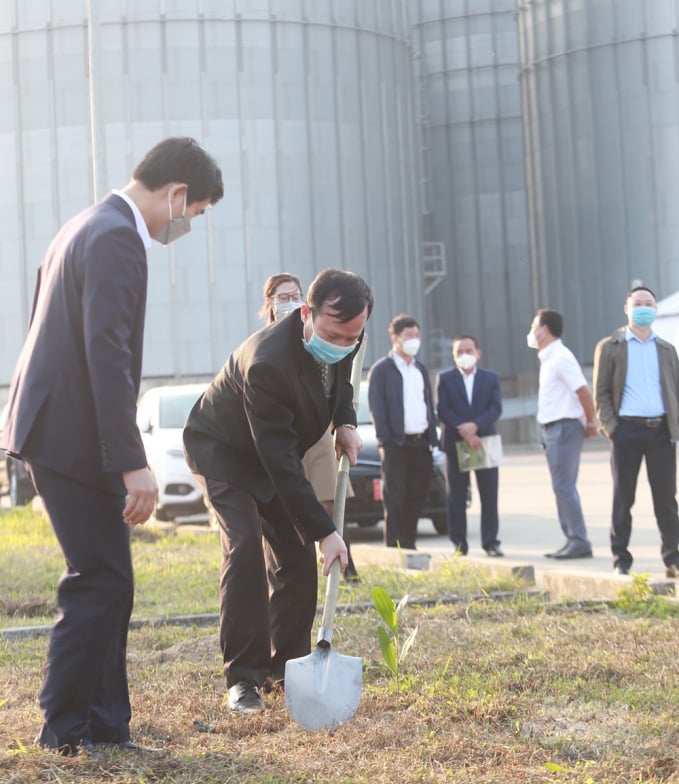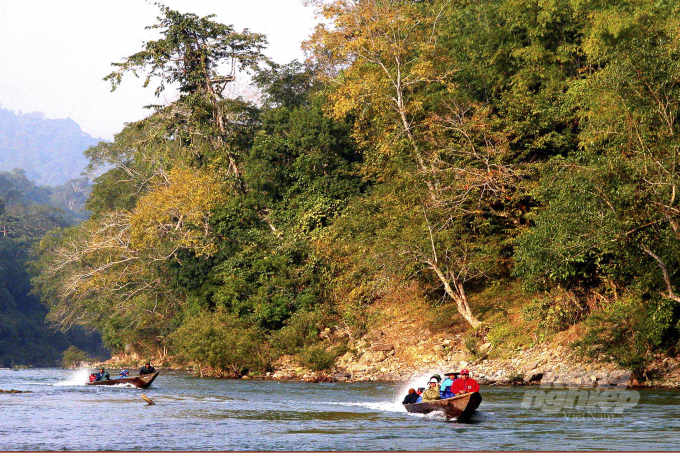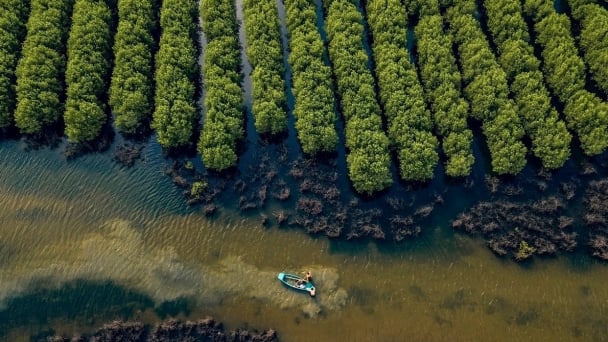June 17, 2025 | 03:37 GMT +7
June 17, 2025 | 03:37 GMT +7
Hotline: 0913.378.918
June 17, 2025 | 03:37 GMT +7
Hotline: 0913.378.918

Biomass Fuel Vietnam and the Sustainable Forest Management Component signed the Cooperation Agreement on December 6. Photo: Viet Khanh.
On December 6, the signing ceremony of the Cooperation Agreement between Biomass Fuel Vietnam Co., Ltd. ('Biomass Fuel Vietnam') and the Sustainable Forest Management Component of the USAID-funded Sustainable Forest Management and Biodiversity Conservation Project, were held at VSIP Industrial Park in Nghe An province.
The Forestry Project Management Board is assigned by the Ministry of Agriculture and Rural Development as the Project Owner of Vietnam Sustainable Forest Management and Biodiversity Conservation (VFBC). The project's objective is to reduce greenhouse gas emissions, increase carbon sequestration in Vietnam's natural and planted production forests, and ensure biodiversity conservation in high-value forested areas.

The cooperation agreement between the two sides is a solid foundation for sustainable development. Photo: Vo Dung.
The Project of Vietnam Sustainable Forest Management and Biodiversity Conservation will be implemented from 2021-2026 and will be implemented in 11 provinces. Nghe An province participates in the Sustainable Forest Management Component with a funding budget of 2 million USD. One of the key objectives is to improve and upgrade the quality of planted forests to closely connect the market between forest owners and wood processing and consumption enterprises.
Biomass Fuel Vietnam was established in 2016 in Nghe An province with a total investment of US$ 24.4 million, which is considered the most modern pellet factory in the country.
The company produces biomass wood pellets, a clean, and environmentally friendly product used as fuel for industrial production plants and thermal power plants.
When in stable operation, the company uses about 320,000 tons of raw materials every year, mainly acacia and pine to produce about 160,000 tonnes of products, with a revenue of approximately US$ 10 million.

One of the agreement's key objectives is to improve and upgrade the quality of planted forests to closely connect the market between forest owners and wood processing and consumption enterprises. Photo: Viet Khanh.
Dr. Vu Van Hung, Deputy Head of the Forestry Project Management Board, Director of the VFBC Project Management Board, affirmed: "I believe that the signing of a Cooperation Agreement between the two sides is not merely a relationship between the Enterprise and the project, with the core being to support forest owners, households, groups of households, and cooperatives in the region to be proactive in sustainable forest management and business, focusing on large timber production; towards international forest certification. Thereby concretizing the project's objectives, and at the same time actively contributing to Vietnam's forestry development strategy for 2021 - 2030 period".
At the signing ceremony, the Vice Chairman of Nghe An Provincial People's Committee, Mr. Hoang Nghia Hieu, emphasized that Nghe An owns the country's most significant forest and forestry land, especially the Western Biosphere Reserve recognized by UNESCO as the largest area in Southeast Asia.
Recently, the forestry sector of Nghe An province maintained an impressive growth rate. As a result, the development of the province's raw material areas associated with processing factories has received attention and focus, and investment mechanisms and policies have been gradually improved.

Nghe An province initially applied a sustainable forest management plan to increase the value of forest products. Photo: Vo Dung.
Nghe An province initially applied a sustainable forest management plan to increase the value of forest products, partially meet the demand of the timber export market, and improve living standards and income for people.
In particular, the Prime Minister has allowed the establishment of a high-tech application forest zone in the North Central region. It is considered a solid foundation, creating a premise to maximize the potential and advantages of the forestry industry in Nghe An in the upcoming future.
However, the management and protection of forest resources and forestry production still face many difficulties and challenges. The quality and efficiency of planted forests are still low, and the forest areas are still limited; Plantation products are mainly exported as raw materials or are processed, leading to low commodity value chains; Investment value for forestry is still low, not meeting the development needs of the forestry industry.

The cooperation agreement between Biomass Fuel Vietnam and the Sustainable Forest Management Component represents the big vision of the Ministry of Agriculture and Rural Development. Photo: VK.
Forest experts said that the cooperation agreement between Biomass Fuel Vietnam and the Sustainable Forest Management Component is directly supported by the United States Agency for International Development (USAID) for projects that have been and are being implemented in Nghe An is the basis to solve the above difficulties.
The Forestry Projects Management Board currently implements three projects in Nghe An, including two loan projects (JICA2, the Forest Sector Modernization, and Strengthening Project - JICA2, and the Forest Sector Modernization and Strengthening Coastal Resilience Project - FMCR); and one grant project (Project on Sustainable Forest Management and Biodiversity Conservation - VFBC). The total of Official Development Assistance capital (‘ODA’) is approximately US$ 21 million.
Translated by Ha Phuc
![Turning wind and rain into action: [4] Bringing climate bulletins to remote and isolated areas](https://t.ex-cdn.com/nongnghiepmoitruong.vn/608w/files/linhnhp/2025/06/14/1152-z6704423696987_15fd32ffc26d590d204d520c9dac6786-nongnghiep-151141.jpg)
(VAN) The Vietnam Agriculture and Nature Newspaper interviewed Mr. Vu Thai Truong, Acting Head of Climate Change and Environment at UNDP Vietnam, to gain deeper insight into how climate bulletins are delivered to farmers.

(VAN) In Tien Giang, a high-tech shrimp farm has developed a distinctive energy-saving farming model that has yielded promising results.
![Turning wind and rain into action: [3] 300.000 farmers benefit from agro-climatic bulletins](https://t.ex-cdn.com/nongnghiepmoitruong.vn/608w/files/news/2025/06/12/e5a48259d6a262fc3bb3-nongnghiep-125122.jpg)
(VAN) The agro-climatic bulletin has become a valuable tool for farmers in the Mekong Delta. After more than five years of implementation, the initiative is gradually being expanded nationwide.
![Turning wind and rain into action: [2] Providing forecasts to the people](https://t.ex-cdn.com/nongnghiepmoitruong.vn/608w/files/news/2025/06/12/e5a48259d6a262fc3bb3-nongnghiep-103927.jpg)
(VAN) In addition to improving the quality of hydrometeorological forecasts, putting forecast bulletins into practical use is crucial for production and disaster prevention.

(VAN) Blue carbon is receiving attention for its rapid absorption capacity and vast potential. It represents a promising nature-based solution to respond to climate change.
/2025/06/11/3507-1-161904_583.jpg)
(VAN) Seagrass beds and coral reefs serve as 'cradles' that nurture life in the ocean depths, creating rich aquatic resources in Vietnamese waters.
![Turning wind and rain into action: [1] Forecasting for farmers](https://t.ex-cdn.com/nongnghiepmoitruong.vn/608w/files/news/2025/06/11/e5a48259d6a262fc3bb3-nongnghiep-111919.jpg)
(VAN) Weather is no longer just a matter of fate. Forecasts have now become an essential companion for farmers in every crop season.